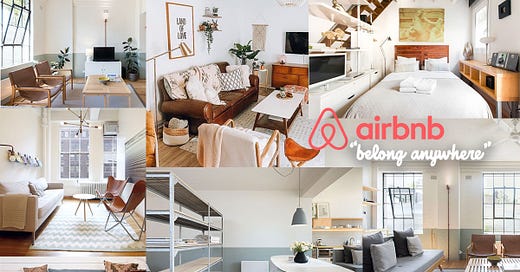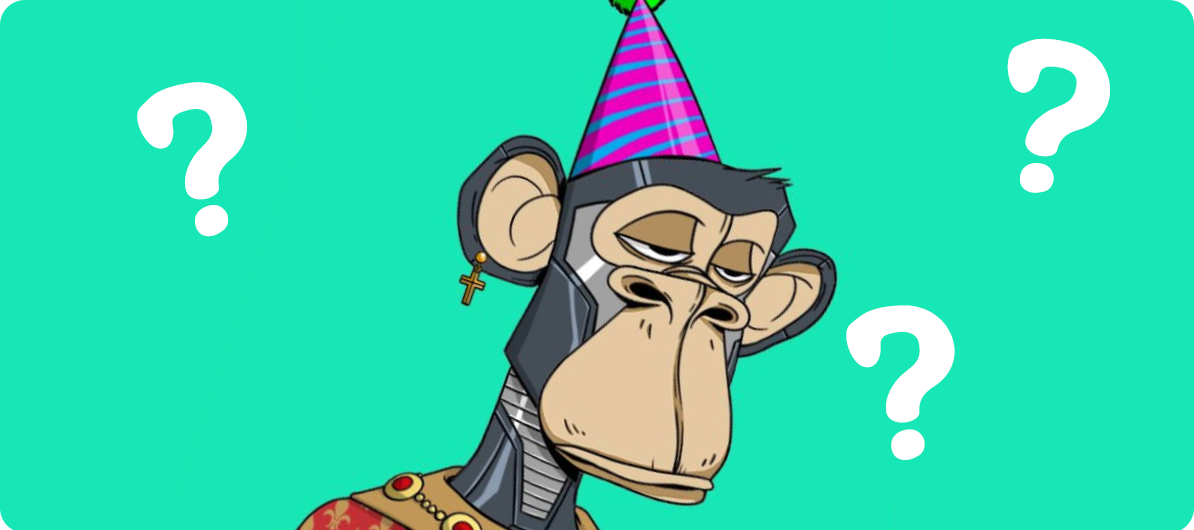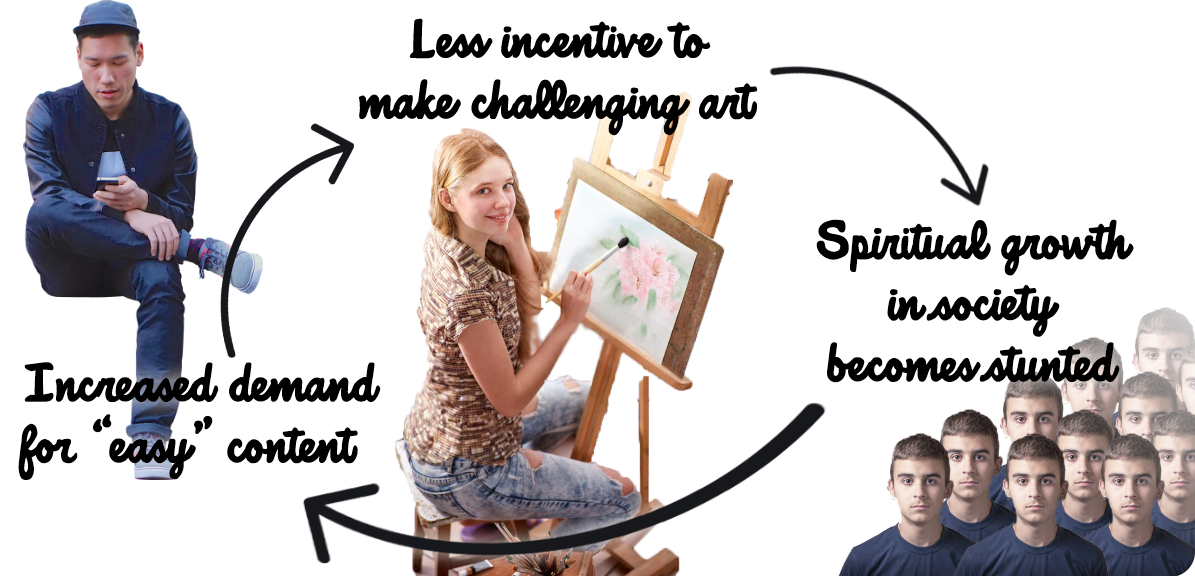The Airbnb-ification of the arts.
How social media nudges the art world towards sterile predictability
The original inspiration for this essay comes from Kyle Chayka’s classic piece “Welcome to Airspace” from 2016. It’s been bouncing around in my head ever since.
A work of art which did not begin in emotion is not art.
― Paul Cezanne
Airbnb was supposed to provide travelers with a more culturally-immersive alternative to the soulless, generic aesthetic of international hotel chains for a similar price. And for a while, it did. But these days the general “vibe” of an average Airbnb rental anywhere in the world can best be described as “San Francisco coffee shop in the early 2010s”. Why? Because the majority of Airbnb hosts aren’t doing “CouchSurfing: elevated.” anymore. They are running a business. And they (like the hotel chains long ago) discovered that while uniqueness has a high appeal to some people; a predictable and familiar aesthetic has a reasonably good appeal to a lot of people.
Let us broadly define art as “something created with the intent of inspiring an emotional response in others”. Now, the art world has never been immune to the gale-force winds of capitalism. In fact, at the highest end, the (financial) value of a piece of art is almost entirely detached from it’s aesthetic qualities. Today, nearly all high-value artwork is bought and sold purely as a financial investment and kept in secure, climate-controlled facilities out of public sight. The impression given is that for most anyone able to afford it, a Basquiat holds about the same emotional significance as an equal amount of gold bars, just with a more predictable price.
For better or worse, the one percent today no longer see themselves as the stewards of high culture. It probably doesn’t help that “high culture” as it exists in 2022 is basically just regular culture with a higher price tag (Consider the oxymoron: “Louis Vuitton streetwear”). The result is that in the highest societal tier achievable by an artist —that is, art that is valuable because it was made by a specific person and thus that person has freedom to be as weird as they want— creative works quickly get snatched up by an investor (as opposed to a “patron”) of the arts, and removed from display.
The remaining 99.99% of working artists operate with the understanding that at the end of the day either their work has to appeal to someone, or it won’t get any attention (or hope of financial return) at all. The eternal struggle all artists face daily is determining how accessible they are willing to make their work before it starts to compromise their integrity and vision.
How much can an artist “sell out” before they become a sellout?
This struggle is nothing new. History remembers the trailblazers and culture celebrates them, but for every artist that successfully nudges the cultural steering wheel, millions are simply forgotten. Artists seeking financial independence have to continuously monitor their output to make sure that it’s not too “out there” so as to be un-marketable. For most of human history this process was done through trial-and-error, and with a lot (read: a lot) of luck. Labels and publishers had ideas about “the next big thing” but the process of knowing meant taking big risks, and (importantly to the topic of this essay) it took time.
Not all artists who fail to change history are forgotten and penniless. In fact the most financially successful artists of the past fifty years are usually the ones who are willing to take that “integrity” slider alllll the way to “sellout” side and produce works with mass-acceptability. Nobody’s favorite, but not offensive either. (Callback to the minimalist vibe of a 2010 San Francisco coffee shop).
To a consumer of art- being challenged by a complex work is rewarding, but it takes a little time and effort. It’s the reason your favorite song probably wasn’t a favorite right away. It took you a while to fully appreciate its nuances. On the flipside- the reason an immediate obsession falls out of your playlist rotation within a few weeks is not because it became bad, more likely there just wasn’t much to it.
Enter Social Media
Social media is hyper-charging the commercial nature of “easy” art. Thanks to the “endless snack buffet” of social media apps, everyday people are no longer “talking about” or “considering” a given work for any meaningful length of time. They are not allowing themselves to be challenged. After all- why waste time on something that doesn’t immediately catch your eye when there’s an endless scroll of content?
The result I suspect is that average consumers are spending less time with (air quotes here) “deep” works, and a ton of time on bite-sized art that’s “good enough”. And it’s not just more time that’s being spent on low-effort art, it’s money.
I don’t mean to disparage candy-fun pop-culture, or imply that anything lighter than Neitzche is not worth making and exploring. There is a place for everything in the human experience. The problem with social media’s influence on art is that the “good enough” fat middle of the art world —where the money is (and just so we’re clear, always has been)— is where all the algorithms will also lead to.
“The Feeling of Bigness is just the lie they sell you”
We all know that likes, follows, and shares can be addictive. We are social creatures and approval from others feels good. Artists especially appreciate the validation from “putting themselves out there”. But it’s important to remember that likes, follows and shares are not organic in the way that handing out fliers for a concert might be. The algorithm knows the “good enough” is what keeps the most people on the platform and so that’s what the algorithm will reward with more attention (and likes). It doesn’t take much to see how an artist might (even subconsciously) start to modify their own work away from what’s most meaningful to them in order to better meet the desires of the algorithm.
A well-established financially secure artist might not be easily swayed by his or her “like” count. But you better believe an emerging one can. And since the trial-and-error period for publishing new works now takes minutes instead of months, artists can even post unfinished drafts and adjust them on the fly if it doesn’t initially “do well”. There are no longer long periods of analysis between publishing; feedback is immediate. Any insecurity one might be feeling about not being “enough” can be now be immediately indulged and expounded. Tweak, tweak, tweak until the likes come in.
To be clear- “the algorithm” is not some arbitrative demigod consciously deciding what gets attention and what languishes in obscurity; in essence, it’s an overly-complex flowchart blindly following the already-established patterns of human nature. The weirder and more “challenging” a work of art is, the fewer people who will intentionally seek it out. And since the job of a social media algorithm is to get the most ads in front of the most eyeballs, it won’t present those posts as often. As a result- the posts get fewer likes, and the artist gets less encouragement when sharing boundary-pushing content, and more encouragement from posts with eye-(or ear)-catching works.
Essentially, social media is treating every artist (well, everyone) like they’re a corporate brand and assuming all sides are motivated purely by financial means. And while money is certainly a motivating factor when creating art, it’s important to recognize that it’s never the only motivating factor. Consider a work created purely for financial gain and without regard for aesthetic or emotional impact. Could such a thing even reasonably be called “art”?
At this point you might be tempted to say “lol that’s capitalism for ya”, and you wouldn’t be wrong, but also consider that the types of content that reached “mainstream” audiences prior to 2008 vs now. The mass-market media ecosystem has shifted hard towards the quickest, easiest-to-digest works that take minimal effort to understand. Something has changed in the past two decades that wasn’t there before.
Back in my day…
Before you dismiss me as a curmudgeonly millennial in nostalgia-colored glasses, realize that I am not implying that art that falls closer to the “challenging” side of the accessibility spectrum has gone away, or that it has a smaller market share (though it wouldn’t surprise me) only that it does not bleed into the mainstream as often as it once did. 1
I am also not implying that before 2008 the average media consumer had more experimental tastes, only that they were more likely to be exposed to experiences outside of their comfort zone. Consider that the only movies to make a large cultural splash anymore are of one genre: action. Action is easy genre to understand and audiences don’t have to work at it as much as they would for say- Being John Malkovitch. Action movies are a safer financial investment because they can still compete in the attention marketplace. The main competition for a movie today isn’t other movies, it’s the smartphone.
But also consider that even the recent Top Gun: Maverick (a “popcorn muncher” if there ever was one) provides it’s audiences with more “challenge” and emotional depth than the most insightful of Instagram Reels. And that fewer and fewer movies today are reaching audiences the size of Maverick.
“A true masterpiece does not tell everything.”
― Albert Camus
“Entertainment” is a motivating factor for those willing to pay for art, but it’s not the factor. Humans ride roller coasters to be entertained2. Humans consume art to feel. With feelings as with finances, low risk is low reward. And social media’s hyper-personalized low-stakes experiences ensure that the risk of not being entertained is very, very low.
You may be reading this and thinking “Say- it sounds like you’re telling me the widespread low-effort content on social media today means the art world has actually become more diverse now than it used to be. That’s the opposite of what’s happened to Airbnb!” and superficially that is true. But the idea is that when people are only exposed to what makes them comfortable they can never be challenged, and can never spiritually grow. I’m sure if Airbnb had a magical 3D printer that could faithfully reproduce everyone’s own bedroom anywhere in the world, most consumers would choose that over a more “authentic experience” too. For now we get “2010 coffee shop” because it’s a much safer investment for people running an Airbnb, similarly to how producing a thousand low-cost TikToks and hoping one goes viral is a safer investment than writing a novel, producing a movie, or making a TV pilot.
Social media platforms reward the creation of comfortable low-stakes content because it keeps people scrolling, but not lingering. The algorithm aims to hold consumers at just the right level of emotional investment that they stay and scroll, but not so much that it begins to feel like effort. The algorithm also (in the form of likes, views, etc) nudges creators away from any deeper, more complicated ideas they may have, and towards producing more of the low (emotional) investment works it knows will maximize eyes on ads. With demand for accessible, marketable art at an all-time high, the result is that nearly all the art encountered in everyday life starts to feel. well, …kinda safe.
For Airbnb hosts, the incentive just wasn’t there to put effort into providing a rich, culturally immersive experience. Those travel experiences are still available for anyone willing to seek them out, but they exist in the margins and often for a premium (either in money or time in the form of planning). And because of social media, the incentive to produce rich, challenging artwork that invites the consumer to linger awhile has nearly exited the mainstream too.
It’s important to remember that there’s nothing preventing these companies from structuring their platforms the way they do. Imagine if Instagram’s algorithm incentivized complexity and depth over bright colors and bikinis. Or if Twitter’s algorithm incentivized tweets that gave full context and didn’t use emotionally charged language.
Oh, what a wonderful world it could be.
“It’s only after you’ve stepped outside your comfort zone that you begin to change, grow, and transform.” ― Roy T. Bennett
When I say “mainstream” I am referring to the way most people today are consuming content. We can only compare the current ecosystem to the recent past since there is no alternative ecosystem today.
For example: network TV is usually considered mainstream, but most people are not mostly watching network TV anymore. Pewdiepie gets millions more views on each video than the top ten highest-rated prime time TV shows combined.
You might say “But those viewers are not as serious, they may be doing other things at the same time and only paying half-attention.” To which I would reply: “exactly”.
There is absolutely an art to roller coaster design but just bear with me here for the sake of analogy









I’ve gotta say it’s gratifying to encounter someone who is seeing the online world of ‘content creation’ and its consequences in a similar way to what I do without giving in to either despair or mere impotent complaining.
‘social media is treating every artist (well, everyone) like they’re a corporate brand and assuming all sides are motivated purely by financial means. And while money is certainly a motivating factor when creating art, it’s important to recognize that it’s never the only motivating factor.’
Maybe it’s because I can remember the pre-internet times (I’m 35) but it’s disturbing to me how much this solely financial/transactional view of creativity has taken hold. ‘Selling out’ is an alien concept or ethical standard to hold now.
Cheers, Justin. Great piece as always.
"Everything Everywhere All At Once" made ~$100 million at the box office.